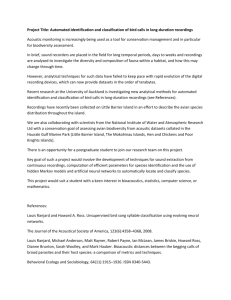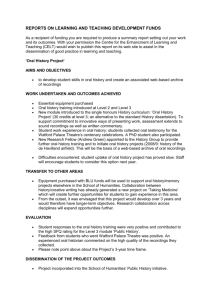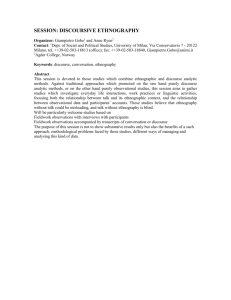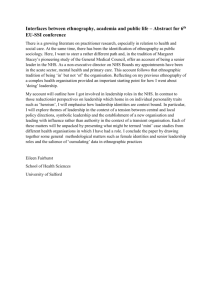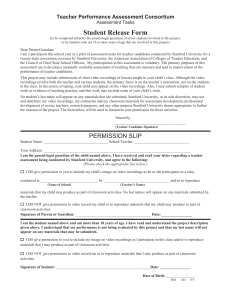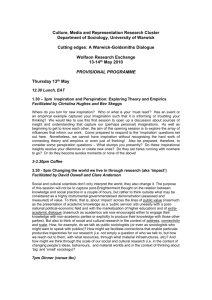Microsoft Word - UWE Research Repository
advertisement
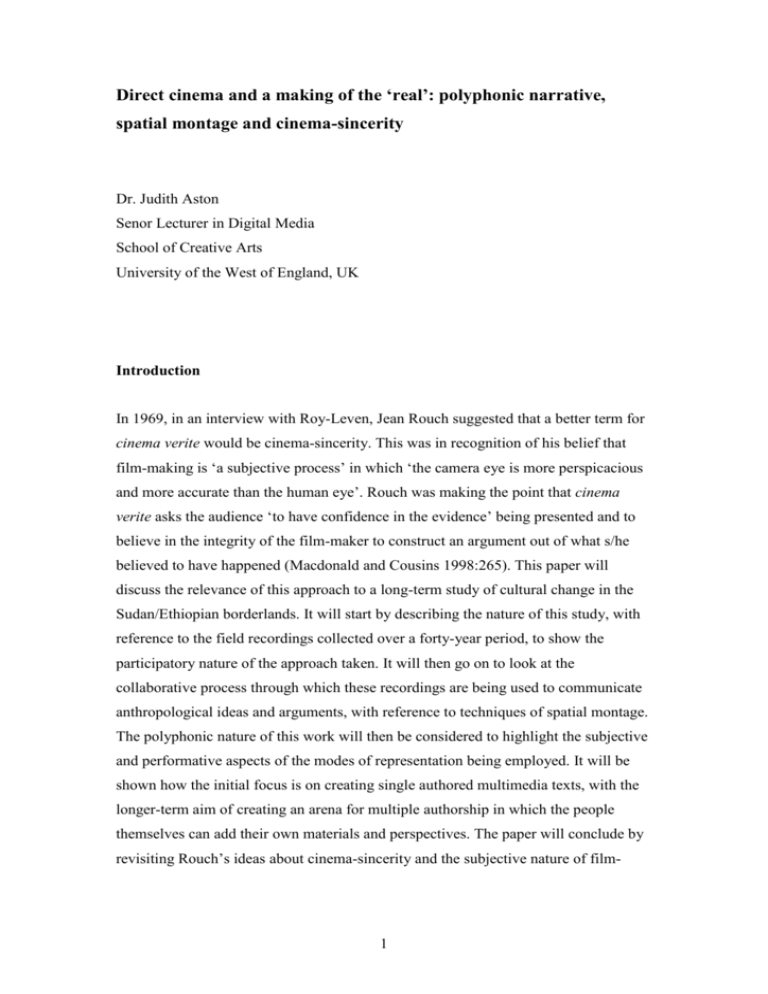
Direct cinema and a making of the ‘real’: polyphonic narrative, spatial montage and cinema-sincerity Dr. Judith Aston Senor Lecturer in Digital Media School of Creative Arts University of the West of England, UK Introduction In 1969, in an interview with Roy-Leven, Jean Rouch suggested that a better term for cinema verite would be cinema-sincerity. This was in recognition of his belief that film-making is ‘a subjective process’ in which ‘the camera eye is more perspicacious and more accurate than the human eye’. Rouch was making the point that cinema verite asks the audience ‘to have confidence in the evidence’ being presented and to believe in the integrity of the film-maker to construct an argument out of what s/he believed to have happened (Macdonald and Cousins 1998:265). This paper will discuss the relevance of this approach to a long-term study of cultural change in the Sudan/Ethiopian borderlands. It will start by describing the nature of this study, with reference to the field recordings collected over a forty-year period, to show the participatory nature of the approach taken. It will then go on to look at the collaborative process through which these recordings are being used to communicate anthropological ideas and arguments, with reference to techniques of spatial montage. The polyphonic nature of this work will then be considered to highlight the subjective and performative aspects of the modes of representation being employed. It will be shown how the initial focus is on creating single authored multimedia texts, with the longer-term aim of creating an arena for multiple authorship in which the people themselves can add their own materials and perspectives. The paper will conclude by revisiting Rouch’s ideas about cinema-sincerity and the subjective nature of film- 1 making to suggest possibilities for an emergent form of on-line ethnography that is both multi-vocal and multi-modal in nature. Participatory recordings from the Sudan Ethiopian borderlands The fieldwork recordings on which this study is based are those of the Oxford anthropologist Wendy James, who has been conducting intermittent fieldwork among the Uduk-speaking people of the Sudan/Ethiopian borderlands since the mid-1960s. When James began this fieldwork, the Uduk were living as subsistence farmers in small hamlet communities. In her first written ethnography on the Uduk, she describes how she was forcibly struck by the importance of the past to them. This caused her to challenge the conventions of traditional ethnography and to publish a written ethnography which explored the link between past and present within Uduk society (James 1979:vii-viii). Since publishing this ethnography, the outbreak of civil war in the Sudan has caused Uduk life to change drastically. In 1987, they were forced to leave their hamlets, as many of them were burnt down by the Sudanese forces and their armed militia among the local nomad Arabs. This initial disruption was followed by a series of further displacements across Ethiopia and the Sudan. Although many of the Uduk died during this time, most of the survivors were living as refugees in Ethiopia up to 2006, when an official repatriation scheme was initiated following the 2005 Sudan Peace Agreement (James 2007:xi). From the outset, James has used audio-visual recording techniques as an integral part of her fieldwork, initially working with Super-8 film, reel-to-reel audio and photographic slides, moving on to Hi-8 video, audio cassettes and SLR cameras, and more recently helping the Uduk themselves to buy their own digital recording equipment. Her fieldwork recordings combine observational recordings of everyday life and events, with interviews and spoken memories. In terms of her sound and moving mage recordings, there is a strong consistency of style, based on the premise of long takes and a largely static camera/microphone in which the events unfold in front of it. What becomes evident as one spends time with the materials, is the extent to which James has become embedded in the community, and that her recordings are based very much on the subjective eye/ear of someone who has gained a good deal of 2 trust among the people she has been studying. Her voice is present in many of the recordings and it is clear that the ‘truths’ that are revealed through these materials are based on a unique set of interpersonal relationships. In 1994, James visited the refugee camp with a film crew to make a documentary for British television (MacDonald 1993) and the rushes for this add another dimension to her archive. She also has materials recorded among the diasporic community in America, and has recently received five DVDs of video footage recorded by one of her informants from America whilst on a recent visit to the site of repatriation in the Sudan. In spanning a forty-year period, these recordings enable comparisons to be made across time and place to show aspects of continuity and change among the Uduk people and their neighbouring communities. The transformation of tradition becomes visible in the refugee camp as formerly separated neighbours are thrown together, and children learn to combine older and newer forms of expression. Many of the materials are highly emotive in nature, combining recordings of dance, music making, work rhythms and children at play, with spoken memories of past events. There are reel-toreel recordings of frogs croaking at dusk in the rural hamlets of the 1960s, video footage of children mimicking frogs in the refugee camp, and video footage of first generation immigrants watching and responding this footage on a video player in Salt Lake City. There are also recordings of music-making and dances performed in the 1960s and recreated in the refugee camps using whatever materials were available at the time. The materials convey a strong sense of resilience in the face of extreme adversity and show how humour is an important aid to survival1. Communicating anthropological ideas and arguments from these materials James and myself have been working intermittently together since the late 1990s when her fieldwork became a case study for my PhD thesis on the potential of interactive multimedia for communicating anthropological ideas and arguments 1 A selection of these materials, focussing on video recordings made a refugee camp between 1994 and 2000, can be seen on the website that we have produced to accompany James’ recent book (James 2007). The videoclip clusters also illustrate some of my early thinking about spatial montage. See www.voicesfromthebluenile.org. 3 (Aston 2003). As a specialist in interactive media production, I have a long-standing interest in anthropology2, and as a specialist in African anthropology, James has had a longstanding frustration with the limitations of the written text as a means of communicating anthropological ideas and arguments. The focus for our initial collaboration was an academic paper written by James on The Names of Fear (James 1997) based on her fieldwork. The aim of the paper was ‘to consider different ways of approaching the ethnographic description and anthropological analysis of emotion, with particular reference to ‘fear’ as conceptualised by the Uduk’ (ibid:1). Focusing on the study of language as a vehicle of conscious and critical self-enquiry, the paper drew upon concrete examples to show how Uduk concepts of fear change through time. These examples were taken from written transcriptions of interviews recorded on camera and were used to illustrate ways in which the Uduk reflect upon the connection between events and experience through their use of language as a living means of discourse. Through our collaboration, we explored a range of ways in which aspects of the written article could be transposed into a multimedia format. The aim was to produce a series of experimental prototypes, in order to consider a range of possibilities for further development. The most fruitful of these experiments involved using techniques of moving-image juxtaposition to make visual comparisons which conveyed aspects of the argument presented in the written paper. Discrete videoclips were placed alongside each other and a fluid interface was developed through which the content of these clips could be interrogated and compared. It was an effective means through which to make visual comparisons across time and to convey multiple points of view relating to a single event. This concept of juxtaposition has informed our subsequent work and has led me into an exploration of new possibilities for revisiting the relationship between spatial and temporal montage brought about by the multiple windows aesthetic of contemporary human computer interfaces. 2 My PhD advisor was Professor Alan Macfarlane, who has been a pioneer in the use of interactive multimedia in Anthropology and with whom I have been associated since the mid-1980s, when I was researching into multimedia in the University of Cambridge. 4 The art historian Lev Manovich coined the term ‘spatial montage’ in relation to his ideas about interactive cinema and emergent cultural interfaces for the 21st century. In his work on The Language of New Media (Manovich 2001) he describes spatial montage as representing an alternative to traditional cinematic montage, replacing its traditional sequential mode with a spatial one (ibid:322). He states, that whilst twentieth century film practice has elaborated complex techniques of montage with different images replacing each other in time, the possibility of a ‘spatial montage’ of simultaneously co-existing images has not been explored as systematically (ibid:323). The advent of an aesthetics appropriate to the user experience of multitasking and the multiple windows of graphical user interfaces offers an opportunity to reconsider this relationship and to create a logic of addition and co-existence which maps well onto what Foucault has called our current epoch of simultaneity (ibid:325). Whereas Manovich has applied these ideas to new forms of film-making, my research is going beyond this to look at ways to integrate moving images with sound, text and still mages, and to create fluid interactive interfaces through which to create new possibilities for the on-line communication of anthropological ideas and arguments. Performative modes of representation and polyphonic ethnography The new forms of on-line communication that I am developing draw on the idea first proposed by Bakhtin that Fyodor Dostoevsky was ‘the creator of the polyphonic novel’ (Bakhtin 1984:7). By this he meant that Dostoevsky’s novels are dialogic in nature, as opposed to the more traditional notion that the novel is a monologic whole, driven by the author’s ideology. He proposed that Dostoevsky’s novels did not combine a ‘multitude of characters and fates into a single objective world, illuminated by a single authorial consciousness’ but into ‘a plurality of consciousnesses with equal rights and each with its own world’ combined ‘but not merged in the unity of the event’ (ibid:6). He also argued that the dialogic nature of Dostoevsky’s novels meant that different social styles are presented through the characters, as opposed to there being an all pervading style dictated by the author. However, since ‘no word is without its intense sideward glance at someone else’s word’ (ibid:203), no character’s speech is entirely independent from that any other character. Bakhtin developed these ideas into his more general theory of ‘heteroglossia’ (Bakhtin 1981) to denote the 5 presence of a multiplicity of voices and a diversity of social speeches and styles in polyphonic and dialogic forms of the novel. In so doing, he was still recognising the personality of the author, along with historical and social context, as being important sources of meaning. In her work, James has recognised that ‘the personal stories of the handful of people’ that she knew well, and who helped her in her original research in the 1960s, ‘weave in and out of the whole tragedy of the Sudanese civil war and the deadly choreography of its entanglements with the struggles in Ethiopia’ (James 1999:xii). She has always made her written ethnographies ‘fieldnote-rich’ (Sanjek 1990:407) and has expressed frustration that ‘the discussion of emotion, culture and language is greatly hampered by the format of written ethnography alone, and even by the written version of the recorded and translated vernacular’ (James 1997:124). Through our collaboration, the aim is to explore possibilities for the creation of on-line forms of multimedia representation, in which James’ becomes both the narrator and a character in the text. In so doing, we are taking her work into more performative modes of representation, to emphasise the subjective or expressive aspects of her own engagement with the Uduk people3. Our aim is to use techniques of spatial montage to combine text, sound, still and moving images in such a way as to tell the story of the events and changes that have occurred as far as possible ‘through the words and experiences of the people themselves’ (James 2007:ix). In this sense, the point of view of the anthropologist as narrator does not take final authority, with contradictory ideas and different styles of speech being able to co-exist in a more dialogic form. James has written that ‘the community of the Uduk-speaking people used to be open to the wider world, permeable, impressionable’ and that ‘their personal identities used to be similarly provisional and shifting’ (James 1999:xvi). However, through becoming refugees, they have been ‘forced by the violent circumstances of the modern world into a straight jacket of a ‘closed’ community publically defined and provided for in terms of national, ethnic and religious identity … a process of which they are to a substantial degree properly aware, and on which they consciously reflect’ (ibid:xvi-ii). The aim of our on-line work is to reflect this self-awareness through the 3 See Nichols 2001 for further definition of the performative mode of documentary making. 6 creation of a series of multimedia texts in which this will become apparent. Initially, we are following Bakhtin’s ideas of ‘heteroglossia’ in which James’, as the anthropologist, still has editorial control over the creation of the final texts. However, in line with Clifford’s vision for polyphonic ethnographic writing (Clifford 1983:140), we are working towards a longer-term aim of opening the work out to new forms of multiple-authorship, as the Uduk people themselves gain greater access to multimedia recording techniques and begin to document their experiences. Since, the Sudan Peace Agreement of 2006, many of them have been repatriated and are no longer refugees. The aim is to enable them to take James’ on-line materials as a starting point through which to create and publish their own ongoing response to what has perhaps once again become the provisional and shifting nature of their personal identities. Conclusion Rouch’s ideas about cinema sincerity and the subjective nature of ethnographic filmmaking have been a clear influence on the development of this work. Whilst the work was initially construed around concepts of participatory modes of representation, more recently it has shifted towards embracing a more performative approach. The reason for this has been to find strategies through which to avoid what has been called the ‘objectifying gaze of social scientists’ in their tendency to present scholarship ‘as a transparent window of explanation that somehow magically and, apparently effortlessly, hid the conditions of knowledge production’ (Ebron 2006:205). By placing James within the work as both narrator and a character, she too becomes a subject of the gaze and enters into a more dialogic relationship with her informants. This has approach has led to consideration of new possibilities for the creation of polyphonic ethnographies, building on James Clifford’s call for approaches to ethnography which recognise ‘the ambiguous multi-vocal world’ of post-colonial anthropology (Clifford 1983:119). By taking this ethnographic work into the digital arena, text, sound and image can be combined in new ways, using techniques of spatial montage, to create work which is both multi-vocal and multi-modal. Examples of this work will be shown in the live multimedia presentation that accompanies this paper. 7 Bibliography Aston, Judith. 2003. Interactive Multimedia: an investigation into the potential of interactive multimedia for communicating ideas and arguments. Unpublished PhD thesis. London: Royal College of Art. Aston, Judith and Wendy James. 2007. www.voicesfromthebluenileorg. Website to accompany James’s latest book (James 2007). Bakhtin, Mikhail. 1981. The Dialogic Imagination. Ed. Michael Holquist. Austin: University of Texas Press. Orig. Russian ed. 1930s. Bakhtin, Mikhail. 1984. Problems of Dostoevsky’s Poetics. Ed. and trans. Caryl Emerson. University of Manchester Press. Orig. Russian ed. 1929. Clifford, James. 1983. On Ethnographic Authority. In Representations, No 2. University of California Press. Ebron, Paulla. 2006. Contingent Stories of Anthropology Race and Feminism. In Feminist Anthropology: a reader. Ed. Ellen Lewin. James, Wendy. 1979. ’Kwanim pa: The making of the Uduk People: an ethnographic study of survival in the Sudan-Ethiopian Borderlands. Oxford: Clarendon Press. James, Wendy. 1999. The Listening Ebony: Moral Knowledge, Religion and Power among the Uduk of Sudan. Paperback edition with new preface. Oxford University Press. Orig. ed. 1988. James, Wendy. 2007. War and Survival in Sudan's Frontierlands: Voices from the Blue Nile. Oxford University Press. MacDonald, Bruce. 1993. Orphans of Passage. Made in collaboration with anthropologist Wendy James, and produced for Granada Television’s Disappearing World war series. 8 Macdonald Kevin and Mark Cousins. 1998. Imagining Reality: The Faber Book of Documentary. Paperback edition. London: Faber and Faber. Manovich, Lev. 2001. The Language of New Media. Cambridge, Massachusetts: MIT Press. Nichols, Bill. 2001. Introduction to Documentary. Bloomington and Indianapolis: Indiana University Press. Sanjek, Roger. 1990. On Ethnographic Validity. In Fieldnotes: the making of anthropology. Sanjek Ed. Cornell University Press. 9
